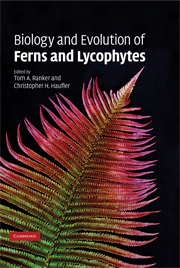Book contents
- Frontmatter
- Contents
- List of contributors
- Preface
- Acknowledgments
- Part I Development and morphogenesis
- Part II Genetics and reproduction
- Part III Ecology
- 8 Phenology and habitat specificity of tropical ferns
- 9 Gametophyte ecology
- 10 Conservation biology
- 11 Ex situ conservation of ferns and lycophytes – approaches and techniques
- Part IV Systematics and evolutionary biology
- Index
- References
10 - Conservation biology
Published online by Cambridge University Press: 11 August 2009
- Frontmatter
- Contents
- List of contributors
- Preface
- Acknowledgments
- Part I Development and morphogenesis
- Part II Genetics and reproduction
- Part III Ecology
- 8 Phenology and habitat specificity of tropical ferns
- 9 Gametophyte ecology
- 10 Conservation biology
- 11 Ex situ conservation of ferns and lycophytes – approaches and techniques
- Part IV Systematics and evolutionary biology
- Index
- References
Summary
Introduction
Within the USA, Connecticut was the first state to pass a plant protection law in 1869, and it was for a fern: Lygodium palmatum populations were declining due to over-collection for horticultural uses (Yatskievych and Spellenberg, 1993). Over a century later, the same fern was the source of a short article in The New York Times on June 16, 1985, which described road relocation negotiations to avoid two patches of the rare Lygodium palmatum in Burlington County, New Jersey (Haitch, 1985). The article reads, “The issue was at a stalemate in December. Score one for the ferns. Burlington will move the road 200 ft. east of the originally planned route to bypass the plants …” (Haitch, 1985). The beginnings of the American Fern Society in 1893, followed quickly by the publication of the Fern Bulletin (for 5¢ each), and later the American Fern Journal in 1910, attest to the early importance of ferns and lycophytes to US aficionados (Benedict, 1941).
There are approximately 13600 named species of ferns and lycophytes globally (Hassler and Swale, 2001; Chapter 14). Because new species continue to be described and because of persistent regional gaps in floristic treatments, the real number of fern and lycophyte species is not yet known. Due to declining abundance or local extirpation, fern and lycophyte species of conservation concern have been identified for certain areas and have become the focus of international conservation efforts.
- Type
- Chapter
- Information
- Biology and Evolution of Ferns and Lycophytes , pp. 257 - 283Publisher: Cambridge University PressPrint publication year: 2008
References
- 11
- Cited by



